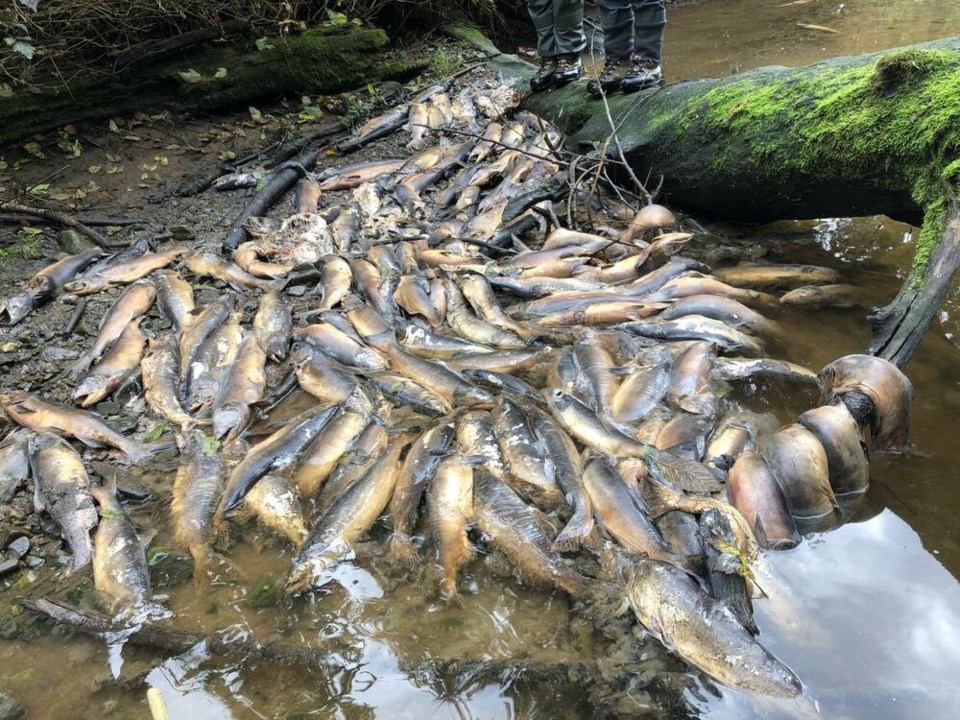It’s a common enough experience. We spend weeks, months, maybe years planning and preparing for an event — then, life suddenly happens, and all those efforts come to nothing.
Maybe a carefully planned surprise party had to be cancelled at the last minute because the guest of honour came down with chicken pox or COVID.
Maybe a family vacation to Disney World over the holidays was instead spent camping in Pearson Airport when a blizzard grounded all flights for days on end. Maybe a big project at work was shelved at the eleventh hour because of the pandemic or a corporate takeover.
As humans, we usually can put these kinds of experiences down to, well, experience, take what good we can out of them, and move on.
But when life happens to critters in the wild, the consequences often are fatal.
The salmon returned to Neekas Creek on the central coast this fall, only to have this year’s ongoing drought throw life at them within mere kilometres of their spawning beds.
In late September, researchers came upon masses of fish floating dead or plastered together along the bottom of Neekas Creek near Spiller Channel, about 25 kilometres from Bella Bella within Heiltsuk Nation Territory.
One of the biologists estimated that some 65,000 salmon, mostly pinks and some chum, were lying in the creek bed. Fewer than 30 per cent had spawned.
It’s a disappointing and worrisome end to a years-long epic journey that was meant to give rise to healthy new generations of salmon.
Two to six springs ago, depending on the species, the salmon tumbled down the creek as smoults from the gravel beds and streams where they hatched. They survived months in the eelgrass beds at the creek mouth, hiding from herons, gulls and eagles, otters, seals and other predators while the young fish bulked up on zooplankton, larvae and water insects.
When they headed out to the open ocean, the challenges continued.
The salmon would have navigated to their preferred ocean homes. Many B.C. salmon apparently gather together and head for the Gulf of Alaska, research by an international team of scientists who spent a month in early 2019 sampling salmon in that region has revealed.
By matching the genetics of salmon caught on the research trip to the known genetic profiles of stocks from rivers along North America’s west coast, the researchers determined, for example, that most coho salmon in the Gulf originate from rivers in northern B.C.
The next largest number of coho were from Queen Charlotte Strait and Johnstone Strait, followed by coho from the Strait of Georgia. Very few coho caught in the Gulf by the research team came from Washington or Alaska rivers.
On that journey and in their ocean home region, the growing Neekas Creek salmon continued to contend with predators. They also competed among their own species and against different sea animals for food to grow and remain healthy.
The pink and sockeye salmon that went to the Gulf of Alaska fed mostly on krill. The coho preferred a diet of tiny snails. The stomachs of the three Chinook salmon sampled were full of squid and other fish. The chum, on the other hand, ate pretty much anything and everything.
During the winters, less food was available, and the salmon had to work harder to eat enough.
And the salmon were doing this even as the north 91įŁ┤┤ is changing, with marine heat waves affecting food availability, abundance and nutrition levels, ongoing losses of sheltering eelgrass beds and kelp forests, and more.
Those of the Neekas Creek salmon that managed to survive all that — and more — then turned around and found their way back to the central coast, instinctively seeking the familiar waters of the creek so they could spawn and give rise to another generation of Neekas Creek salmon.
But for most of the estimated 65,000 pinks and chum found dead in the lower reaches of the parched creek earlier this fall, their epic migration ended before they could complete its final and vital reproductive stage. Their own individual genetic lines are now dead ends.
The die-off of two species in the creek bodes ill for salmon in similar drought-stricken creeks throughout B.C. — and for the communities and ecosystems that rely on these iconic fish.
>>> To comment on this article, write a letter to the editor: [email protected]



